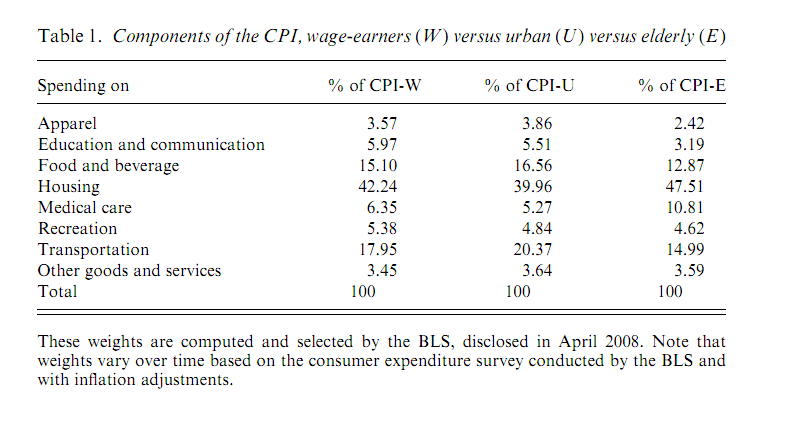A price index such as the consumer price index (CPI) is intended to provide a rough gauge of the general direction of prices in the economy.
An increasing consumer price index represents price inflation while a decreasing price index may provide an indication of deflation.
The CPI is an important index because the government uses it to make significant policy decisions. For example, the recent decision to allow a 3.6 percent cost of living adjustment for Social Security was based on a version of the CPI.
The various “versions” of the consumer price index are a subject of contentious debate. Many argue that decisions that affect retirees should be based on a price index that is relevant to the consumption patterns of retirees.
This makes quite a bit of sense when looking at the composition and weighting of various price indexes.
Consider, for example, the following table from a paper written on this topic from Moshe Milevsky:

One can see in the table above that the consumer price index for the elderly (“CPI-E”) has weightings that are skewed more heavily towards medical care and housing expenses. Again, this makes quite a bit of sense given the fact that most seniors spend a relatively large amount of their disposable income on medical care and housing.
Further, as indicated in the paper by Moshe Milevsky, the overall rates of inflation among the three indexes differ. The CPI-E has increased at a more rapid rate than the CPI-W over the past 25 years based on a consistent differential (50 basis points or one half of one percent) between the two indexes.
This difference is meaningful for retirees since critical financial decisions and public policy decisions are generally pegged to the “non-elderly” indexes.
In addition, the difference between the CPI-E and other non-elderly indexes will likely increase in the coming years as healthcare expenses continues to escalate.
- tom's blog
- Log in to post comments

